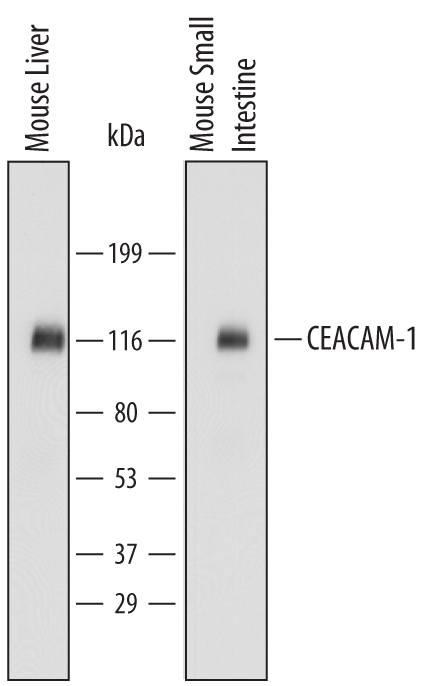Mouse CEACAM-1/CD66a Antibody Summary
Met1-Gly428
Accession # P31809
Applications
Please Note: Optimal dilutions should be determined by each laboratory for each application. General Protocols are available in the Technical Information section on our website.
Scientific Data
 View Larger
View Larger
Detection of Mouse CEACAM‑1/CD66a by Western Blot. Western blot shows lysates of mouse liver tissue and mouse small intestine tissue. PVDF Membrane was probed with 0.1 µg/mL of Mouse CEACAM-1/CD66a Antigen Affinity-purified Polyclonal Antibody (Catalog # AF6480) followed by HRP-conjugated Anti-Sheep IgG Secondary Antibody (Catalog # HAF016). Specific bands were detected for CEACAM-1/CD66a between approximately 110 and 120 kDa (as indicated). This experiment was conducted under reducing conditions and using Immunoblot Buffer Group 1.
 View Larger
View Larger
Detection of CEACAM-1 in Mouse Splenocytes by Flow Cytometry. Mouse splenocytes were stained with Sheep Anti-Mouse CEACAM-1/CD66a Antigen Affinity-purified Polyclonal Antibody (Catalog # AF6480) followed by Phycoerythrin-conjugated Anti-Sheep IgG Secondary Antibody (Catalog # F0126) and Rat Anti-Mouse B220/CD45R APC-conjugated Monoclonal Antibody (Catalog # FAB1217A). Quadrant markers were set based on control antibody staining (Catalog # 5-001-A).
 View Larger
View Larger
CEACAM‑1/CD66a in Mouse Liver. CEACAM-1/CD66a was detected in perfusion fixed frozen sections of mouse liver using Sheep Anti-Mouse CEACAM-1/CD66a Antigen Affinity-purified Polyclonal Antibody (Catalog # AF6480) at 5 µg/mL overnight at 4 °C. Tissue was stained using the NorthernLights™ 557-conjugated Anti-Sheep IgG Secondary Antibody (red; Catalog # NL010) and counterstained with DAPI (blue). Specific staining was localized to endothelial cells in bile canaliculi. View our protocol for Fluorescent IHC Staining of Frozen Tissue Sections.
Reconstitution Calculator
Preparation and Storage
- 12 months from date of receipt, -20 to -70 °C as supplied.
- 1 month, 2 to 8 °C under sterile conditions after reconstitution.
- 6 months, -20 to -70 °C under sterile conditions after reconstitution.
Background: CEACAM-1/CD66a
CEACAM-1 (Carcinoembryonic antigen-related cell adhesion molecule 1; also BGP-1, CD66a and MHVR1) is a 110-120 kDa member of the CEACAM subfamily, CEA family of proteins. It has a wide expression pattern, being found on neutrophils, dendritic cells, endothelial cells, colonic epithelium and hepatocytes. It mediates cell adhesion, and appears to regulate insulin levels and signaling by interacting with the insulin receptor. It also demonstrates proangiogenic effects by inducing endothelial cells to proliferate and form capillary-like tubules. Finally, CEACAM-1 is a known receptor for mouse hepatitis virus. Mature mouse CEACAM-1 is a 487 amino acid (aa) type I transmembrane glycoprotein. Its contains a 394 aa extracellular region (aa 35-428) that shows one V-type (aa 35-142) and three C2-type
(aa 147-411) Ig-like domains, plus a 74 aa cytoplasmic domain. Three alternate splice forms exist. One contains a four aa substitution for aa 455-521, a second shows a Gln substitution for aa 142-322, and a third possesses a combination of the first two splice patterns. CEACAM-1 forms homodimers. Over aa 35-428, mouse CEACAM-1 shares 56% and 70% aa identity with human and rat CEACAM-1, respectively.
Product Datasheets
Citations for Mouse CEACAM-1/CD66a Antibody
R&D Systems personnel manually curate a database that contains references using R&D Systems products. The data collected includes not only links to publications in PubMed, but also provides information about sample types, species, and experimental conditions.
3
Citations: Showing 1 - 3
Filter your results:
Filter by:
-
SOX10 requirement for melanoma tumor growth is due, in part, to immune-mediated effects
Authors: SR Rosenbaum, M Tiago, S Caksa, C Capparelli, TJ Purwin, G Kumar, M Glasheen, D Pomante, D Kotas, I Chervoneva, AE Aplin
Cell Reports, 2021-12-07;37(10):110085.
Species: Mouse
Sample Types: Cell Lysates
Applications: Western Blot -
Development of A New Mouse Model for Intrahepatic Cholangiocellular Carcinoma: Accelerating Functions of Pecam-1
Authors: IA Malik, G Malik, P Ströbel, J Wilting
Cancers (Basel), 2019-07-24;11(8):.
Species: Mouse
Sample Types: Whole Tissue
Applications: IHC-Fr -
One Year Follow-Up Risk Assessment in SKH-1 Mice and Wounds Treated with an Argon Plasma Jet
Authors: A Schmidt, TV Woedtke, J Stenzel, T Lindner, S Polei, B Vollmar, S Bekeschus
Int J Mol Sci, 2017-04-19;18(4):.
Species: Mouse
Sample Types: Whole Tissue
Applications: IHC
FAQs
No product specific FAQs exist for this product, however you may
View all Antibody FAQsReviews for Mouse CEACAM-1/CD66a Antibody
There are currently no reviews for this product. Be the first to review Mouse CEACAM-1/CD66a Antibody and earn rewards!
Have you used Mouse CEACAM-1/CD66a Antibody?
Submit a review and receive an Amazon gift card.
$25/€18/£15/$25CAN/¥75 Yuan/¥2500 Yen for a review with an image
$10/€7/£6/$10 CAD/¥70 Yuan/¥1110 Yen for a review without an image


